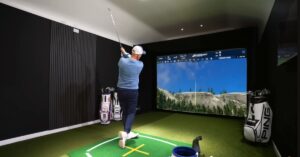Do Golf Tees Make A Difference? [Know Your Gears]
In golf, small details matter. Your swing, score, and gameplay depend on more than just a good swing or club. Surprisingly, the golf tee also impacts your success.
Yes, golf tees do make a difference in your game. The type, material, and height of the golf tee can alter your results, with more experienced players potentially seeing a notable difference if they opt for the wrong kind of tee.
In this blog post, we will explore the significance of golf tees and explore how they can impact your performance on the green.
![Do Golf Tees Make A Difference? [Know Your Gears] 1 Do Golf Tees Make A Difference](http://giftedgolfers.com/wp-content/uploads/2023/05/image-114.png)
How Golf Tees Impact Your Game?
Golf tees play a crucial role in the game of golf, particularly when it comes to driving the ball off the tee. Here are some ways in which golf tees can impact your game:
Elevation
The height at which you tee up the ball can affect the angle at which you strike it.
By adjusting the tee’s height, you can optimize your launch angle and achieve the desired trajectory for your shots.
A higher tee can help you hit the ball higher and farther, while a lower tee can promote a lower trajectory for better control.
Stability
Golf tees provide stability to the ball by keeping it elevated above the ground.
This stability helps golfers achieve a clean strike on the ball, reducing the chances of mishits or shots that dig into the turf.
When the ball is teed up correctly, it allows the clubface to make clean contact with the ball, resulting in better distance and accuracy.
Consistency
Using a tee allows you to have a consistent setup for your drives.
Placing the ball at the same height every time helps you develop a consistent swing and strike the ball with the desired clubface angle.
Consistency in teeing height can lead to more predictable shots and improved accuracy.
Shot shape
The type of golf tee you use can influence the shot shape you can achieve.
Different tee designs, such as low-resistance tees or adjustable tees, can affect the spin and launch characteristics of the ball.
Some tees are designed to minimize friction between the ball and the tee, potentially reducing side spin and promoting straighter shots.
Course conditions
Golf tees can be chosen based on the specific conditions of the golf course.
For example, longer tees may be used on tee boxes with thicker grass or in wet conditions to help ensure a clean strike.
In contrast, shorter tees might be used on hard or tightly mown surfaces to provide the right amount of elevation.
It’s worth noting that while golf tees can impact your game off the tee, they are not relevant for shots played from the fairway, rough, or around the greens. However, understanding how to use tees effectively can enhance your performance when it comes to driving the ball.
Types Of Golf Tees You Will Find
![Do Golf Tees Make A Difference? [Know Your Gears] 2 image 116](http://giftedgolfers.com/wp-content/uploads/2023/05/image-116-1024x552.png)
There are several types of golf tees available in the market, each offering its own advantages and suitability for different golfers. Here are some common types of golf tees:
Wooden Tees
Wooden tees are the traditional and most commonly used type of tee. They are usually made of wood and come in various lengths.
Wooden tees are inexpensive, disposable, and provide decent stability for the ball.
They are suitable for most golfers and are available in different sizes to accommodate different clubhead sizes and personal preferences.
Plastic Tees
Plastic tees are made from durable materials such as polycarbonate or composite plastics.
They offer durability and can withstand multiple tee shots without breaking.
Plastic tees are often available in different lengths and may have additional features such as flexible prongs or brush-like heads to reduce friction and resistance when the club contacts the ball.
They are reusable and can last longer than wooden tees.
Brush Tees
Brush tees feature a brush-like head instead of a traditional cup-shaped top. The bristles hold the ball in place while reducing friction and resistance during impact.
Brush tees are designed to minimize the contact area between the ball and the tee, potentially reducing spin and promoting longer, straighter drives.
They are particularly popular among golfers who prioritize distance and accuracy off the tee.
Zero Friction Tees
Zero friction tees are typically made of a plastic or composite material and feature prong-like structures or a small cup at the top to hold the ball.
These tees are designed to reduce the contact area between the ball and the tee, resulting in less friction and potentially increased distance.
Zero friction tees can provide a consistent tee height and are often reusable.
Adjustable Tees
Adjustable tees allow golfers to change the tee height based on their preferences or specific shot requirements.
These tees usually consist of a base or stem with a movable cup or prong system. Golfers can adjust the tee’s height by simply sliding or twisting the top portion.
Adjustable tees provide versatility and allow golfers to optimize their launch angle and ball trajectory for different clubs and shot types.
What Golf Tees Do The Pros Use?
Professional golfers use a variety of golf tees based on personal preference and the specific needs of their game.
While it’s challenging to provide an exhaustive list of tees used by all professional golfers, here are a few types that are commonly used by the pros:
- Wooden Tees
- Plastic Tees
- Brush Tees
- Custom Tees
How To Choose The Best Golf Golf Tees For Your Game?
![Do Golf Tees Make A Difference? [Know Your Gears] 3 image 115](http://giftedgolfers.com/wp-content/uploads/2023/05/image-115-1024x571.png)
Choosing the right golf tees for your game is important for optimizing your performance and ensuring a smooth tee shot. Here are some factors to consider when selecting the best golf tees:
Tee Height
The height of the tee can affect your shot trajectory and distance. For drivers and fairway woods, the tee should be set higher to allow for a sweeping motion.
For irons, a lower tee height is recommended. Choose a tee that allows you to easily adjust the height based on your club selection.
Tee Material
Golf tees are typically made of wood or plastic. Wooden tees are the most common and provide a traditional feel.
They are generally inexpensive and biodegradable. Plastic tees are more durable and can be reused multiple times.
They also offer more consistency in tee height. Decide which material suits your preference and playing style.
Tee Length
Golf tees come in various lengths, ranging from 2.75 inches to 4 inches or more.
Longer tees are suitable for drivers and other large-headed clubs, while shorter tees work well for irons and hybrids.
Consider the club you use most frequently off the tee and choose a tee length that allows you to position the ball at the ideal height.
Tee Design
Golf tees come in different designs, including traditional wooden pegs and performance tees with specialized features.
Performance tees often have pronged or brush-like tops that reduce friction and allow for less resistance at impact, potentially resulting in increased distance.
Experiment with different designs to find one that suits your swing and provides the desired ball flight.
Tee Durability
Consider the durability of the tee, especially if you prefer plastic tees.
Some plastic tees are sturdier and can withstand multiple rounds without breaking, while others may be more prone to damage.
Look for tees that are known for their durability to ensure they last longer.
Personal Preference
Ultimately, your personal preference and comfort with a specific tee play a significant role in your selection.
Try out different tees during practice rounds or casual games to see which ones you prefer in terms of feel, performance, and consistency.
Environmental Considerations
If you’re environmentally conscious, consider using eco-friendly tees made from biodegradable materials.
These tees break down more easily over time and have a smaller impact on the environment.
FAQs
As we come to the end, let’s address some commonly asked questions regarding golf tees for a comprehensive understanding.
Do all golfers use tees?
Not all golfers use tees; some prefer to hit off the ground, but using a tee can provide more accurate hits and greater distances.
Can tee really reduce friction?
Certain golf tees, such as the 4 Yards More Reduced Friction tee, make assertions about their ability to diminish friction and contribute to enhanced driving distance.
What length of golf tee should I use?
The length of the golf tee is determined by your height and swing type, with the most commonly used tee lengths being 2 ¾ inches, 3 ¼ inches, and 4 inches in popularity.
What tees do professional golfers use?
Pro golfers often use tees like the Zero Friction Power 3 Tee, which claims to add five or more yards to drives. However, the choice can vary based on personal preference and comfort.
Final Words
Knowing how golf tees affect your game can give you an advantage on the course.
Think about tee length, material, and type to improve your play and enhance your overall golfing experience.
Remember, even the smallest details in golf can make a big difference.
So, tee off confidently with the knowledge to make the right choice. Enjoy your game!



![Do You Wear Golf Shoes At A Simulator? [Don’t Miss out!] Do-You-Wear-Golf-Shoes-At-A-Simulator](https://giftedgolfers.com/wp-content/uploads/2023/08/Do-You-Wear-Golf-Shoes-At-A-Simulator-300x156.jpg)


